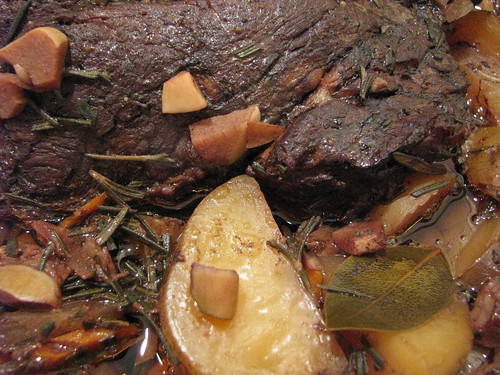We're all busy this time of year. On top of the craziness of the season some of us are plagued by colds and longer commutes due to icy roads, are frantically wrapping up the 4th quarter at work, or working long hours launching a new business (hey, that's us!). Few of us have the luxury of a private chef. Or a even butler named Hobson to take your coat and offer you a hot toddy when you return home. How nice would that be! Sigh...
Pull out that crockpot, fill it with a few choice ingredients, and when you come home from work you can pretend that Hobson spent all day whipping up a perfect hot meal for you. After a long hard day there's nothing like coming home to the aromas of a hearty home-cooked meal. Just lift the lid and serve.
Beef Pot Roast
Large cut of beef pot roast
2 cups red wine
2 cups water
Yellow potatoes, quartered
Onions, quartered
Carrots, roughly chopped
1 Bay leaf
1 sprig rosemary
2 cloves garlic
Salt and pepper
Marinate the meat overnight in the red wine, keeping liquid after marination. Sear both sides of the roast then place in the crockpot. Add all other ingredients, including the red wine marinade, cover and set crockpot to manufacturers recommended setting.












Comments
December 17, 2008
Sherri, the deep brown colour of this roast is "comfort"...wonderful!
December 17, 2008
The Science of Pot Roast.
There are two critical parts of what makes pot roast a pot roast.
The first is the browning or char of the meat. This creates a delicious taste that also gets mixed into the liquid that you are braising the meat in. Many recipes also recommend flowering the meat before charing. The major purpose of this, is that it both thickens the stock, and more readily passes the charred flavor to the liquid.
The second, and most important part. The connective tissue. The standard pot roast is the chuck roast. Other roasts will simply not stand up to a long braising, and because of their lack of connective tissue, can become, ironically, dry.
Connective tissue, at a temperature slightly below boiling (208 degrees I believe), for about 3-4 hours, will convert from a long extremely difficult to cut fiber (its what keeps us together while we are alive) into gelatin. Yes, that Cosby'esque bit of juicy wiggliness.
Two things will let you know this has happened. First is that the meat just falls apart. That is because the connective tissue, is no longer connecting. The second thing, is that it is packed with "juice" this is the gelatin expressing itself into the meat.
This is why you cook in a liquid. If you didn't the magic wouldn't happen.
Once the magic has happened, you want to stop "cooking" the food as you do not want the gelatin to escape from the roast into the liquid. You can plate and serve at anytime.
If the dish has gone cold, simply reheat. As a matter of fact, reheated pot roast is even extra-delicious because the gelatin is usually just melted and slightly coagulated, which is really tasty. MMMM.... Leftover pot roast!
This is NOT the same kind of moisture that comes from melted fat, which makes your prime meats and grilled steaks so good. The gelatin is NOT fat, is instead a nice delicious protein.
Enjoy your holiday pot roast!
December 17, 2008
SInce ther previous poster brought up left over pot roast, I'll have to chime in.
One of my all time favorite Breakfasts is Pot Roast Hash!
Heres the trick; you want to brown and carmelize your veggies and meat so your need to separate the vegetables and meat from the liquid to start. Coarsly chop and then brown up your Hash in a little bit of olive oil. When it get's a nice crispy exterior top with a couple of poached eggs and a little reduced jus from the pot roast.
If you wanted some extra richness and calories a topping of bernaise sauce wouldn't hurt this dish.
That is a true comfort brunch.
December 18, 2008
We just had pot roast last night! MMMMM, good. A few other notes for folks to consider:
You can expand your range of flavors to keep it interesting without taking away its old school charm. For years, my baseline liquid for cooking has been a greek-i-fied version using red wine, water, bay leaf, a couple tablespoons of tomato paste (brown it first for more flavor), oregano, and a touch of cinnamon. A huge hit every time presented.
Last night we took it a different direction, because I only had enough red wine for my drinking needs: white wine (a Kakheti from Georgia) and water, four big cloves of garlic (whole), bay leaf, the browned tomato paste, and a liven-it-up spice mix of cumin, hot Spanish paprika, cardamon, and a few juniper berries. This sounds really weird as I write it, but the conservative palates at my house ate it up. No potatoes -- shredded it and put it on pasta, after reducing the liquid by about half. Keep things light, and try it.
December 18, 2008
This photo is amazing! You can see the detail on the meat so well.